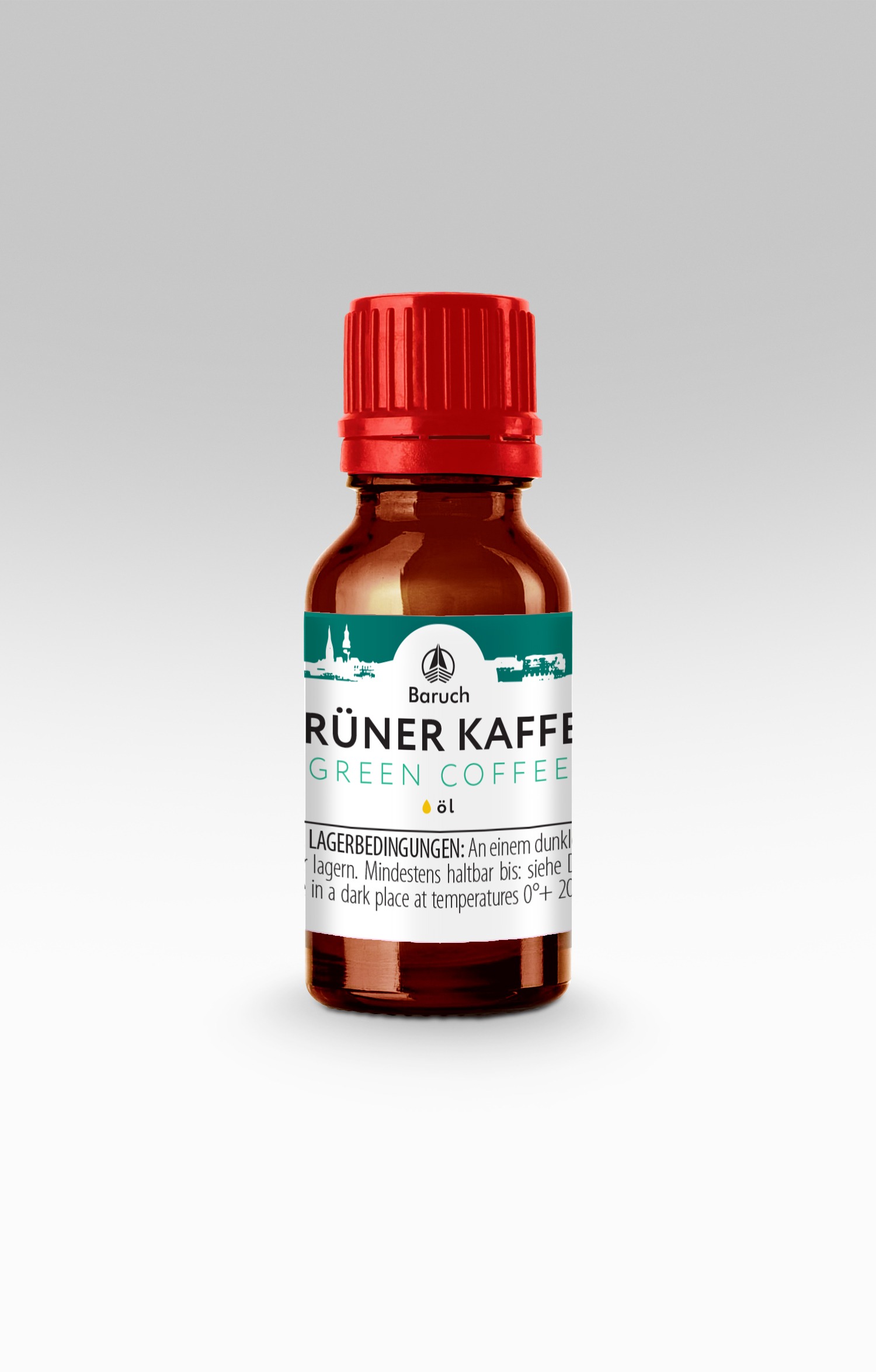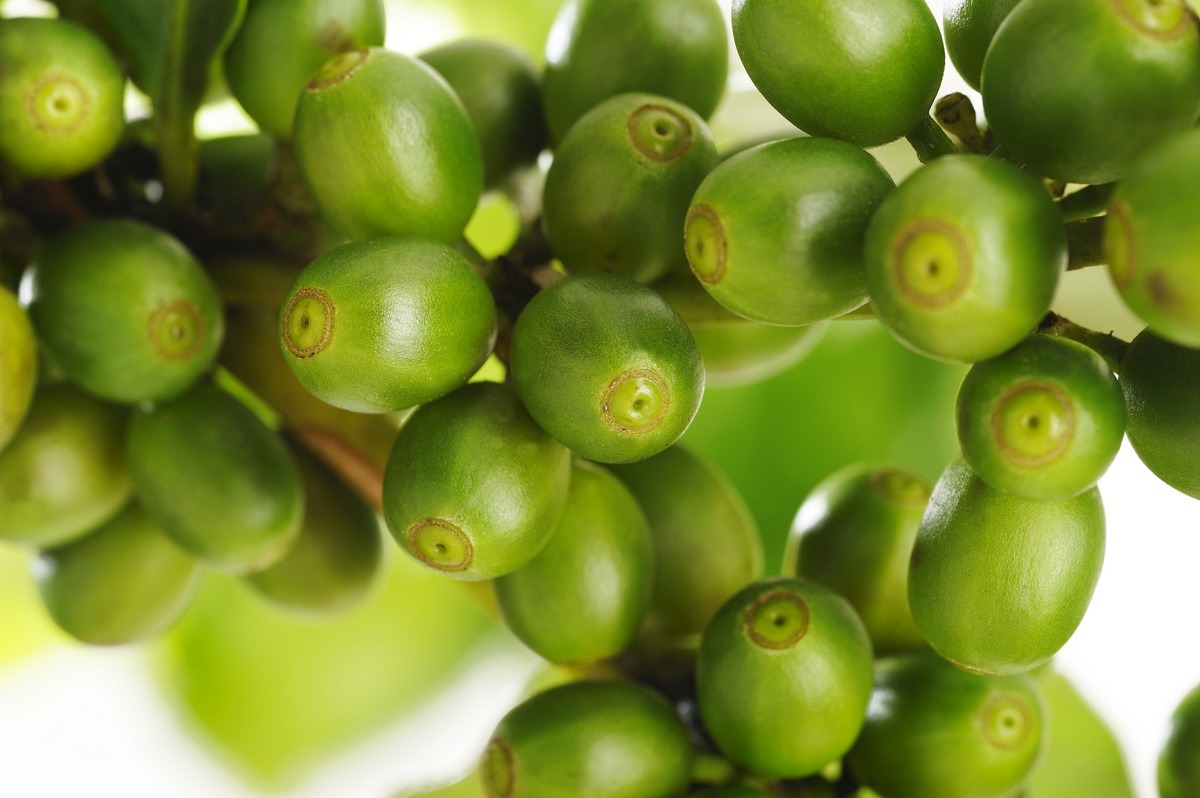Green coffee CO2 extract is one of Biozevtika’s most unique products. Similar extracts made by subcritical extraction technology are not available on the market.
Preparations based on green coffee oil contain a large number of different biologically active compounds. It has been proven that their use speeds up metabolism and allows you to quickly “burn” accumulated fat. Green coffee bean oil reduces skin damage caused by UV radiation. At the same time, the composition of cold-pressed green coffee oil is mainly formed by a complex of fatty acids and phytosterols. Other lipophilic bioactive ingredients are transferred into the oil as secondary components in much lower concentrations than in the “cold”, subcritical extraction. Biozevtika CO2 green coffee extract is made from green, unroasted coffee beans and contains the full range of natural lipophilic compounds characteristic of this type of raw materials (at the same time we also produce black coffee extract from roasted beans, but for completely different purposes – it is used in the food industry used as a flavor additive).
Green coffee CO2 extract has effective healing properties in cosmetic applications. It activates metabolic processes, especially fat and hydrogen metabolism, softens and protects the epidermal layer, improves elasticity, moisturizes and smoothes the skin, and prevents skin aging. The extract has anti-inflammatory properties and is a powerful antioxidant. It strengthens the hair and, thanks to its ability to normalize the water-fat metabolism, has an anti-cellulite effect.


Chart 1. Main components of green coffee CO2 extract
| NAME | CONTENT IN% OF THE AMOUNT OF VOLATILE COMPONENTS | EFFECT |
|---|---|---|
| Palmitic acid | 31 | Unsaturated fatty acid for hydrophobing in cosmetics. |
| Caffeine | 16 | Stimulates the central nervous, cardiovascular and respiratory systems. Relieves brain spasms. Increases mental and physical performance. Anti-cellulite, anti-edematous, antioxidant action. Stimulates microcirculation. UV skin protection. |
| n-Hexanal | 11 | Corrects the immune system, stimulates metabolism, improves and normalizes activity. |
| Caproic acid | 2,9 | Saturated fatty acid. It is well applicable in cosmetics for dry skin. |
| Linoleic Acid | 1,6 | An omega-6 class essential unsaturated fatty acid. It has anti-inflammatory, vasoconstrictive and aggregating effects. If there is no balance between omega-3 and omega-6 fatty acids, competing processes can occur that affect metabolism. |
| Linolenic Acid | 1,3 | An omega-3 unsaturated essential fatty acid. It has a membrane-protecting, angioprotective effect. Immunomodulatory, improves brain metabolism. Anti-inflammatory, wound healing, calming. |
| Oplopanone | 1,2 | There are no data from clinical trials on the effect of the compound. Likely to have anti-inflammatory and immunomodulatory properties. |
| Isopropyl Myristate | 0,8 | An effective moisturizer for dry, aging and dehydrated skin. Good for softening the skin. |
| Palmitolactone | 0,8 | Has a hepatoprotective effect. |
| Isopropyl Palmitate | 0,6 | mollient, moisturizer, absorbs instantly into skin leaving it velvety soft. Moisturizes dry hair and improves combability. Protects hair follicles from damage. |
Green coffee CO2 extract can be recommended for use in cosmetic and pharmaceutical products with the following spectrum of activity:
- Hemostatic
- Antiphlogistic
- Antioxidant
- Anti-cellulite
- antispasmodic and analgesic
- Contribution to the breakdown of fat
- Normalization of the water-fat metabolism in the skin
- Contribution to the constriction of capillaries in the skin
- Slows down the skin’s aging process, reducing the appearance of wrinkles
- Providing long-lasting hydration and smoothing, increasing skin elasticity
- Protective and anti-stress agents
- Sunscreens
- Products to strengthen hair, improve hair growth and restore shine
- Means for eliminating stretch marks and scars
- Products for the care of sensitive and dry skin
Chart 2. Application rates, recommendations for use and storage of CO2 extracts
| Food usage rates | The recommended range of use for the most popular 10% oil solutions of CO2 extracts among technologists in the cosmetic industry (item A10 according to our internal classification) is 0.05-0.5% of the mass of the finished product (0.5-5 g / kg or 0.5-5 kg/ton). For extracts from solutions of other concentrations (A1-A100), the application rates must be recalculated proportionately. |
| Recommendations for use | It is recommended to add CO2 extracts in the final stages of preparation, in the cooling phase of the end product. |
| Storage Instructions | It is recommended to store CO2 extracts in a closed container in a cool room and avoid direct sunlight. |
Historical reference

Ethiopia is the birthplace of coffee and to date this country is the only one where this plant grows wild and most of the coffee bean crop is harvested from wild bushes rather than plantations. Ethiopia has long banned the export of green coffee beans in order to maintain its monopoly on trade in this popular aromatic drink, but in the end the bans did not help, the seeds were exported, and coffee was fully grown all over the world, literally in all warm and hot countries like Brazil, Dominican Republic, Yemen, Guatemala, Jamaica, Kenya and many others.
Much of the history of coffee consumption is linked to an invigorating aromatic drink made from roasted and ground beans of this plant, and green beans have long been overshadowed. And only in our time, with the development of chemical analysis tools, attention was paid to them, and it was discovered that green grains are a whole storehouse of healthy substances, many of which are lost during heat treatment. This discovery gave a rapid impetus to the development of the industry of production and consumption of already green and not black (roasted) coffee for both food and cosmetic (as well as pharmaceutical) purposes.
